disk-io
现在环境中 etcd 数据目录独立挂盘,看磁盘命名应该是个 lv
df -h 查看到类似
/device-mapper
和 lvm 相关 https://wiki.archlinux.org/index.php/LVM
pvs https://linux.die.net/man/8/pvs
iotop
iotop -n 1 -b -o
iostat
监控变化
watch -n 2 -d “xxx”
自动执行
watch -n 2 “xxx”
现在环境中 etcd 数据目录独立挂盘,看磁盘命名应该是个 lv
df -h 查看到类似
/device-mapper
和 lvm 相关 https://wiki.archlinux.org/index.php/LVM
pvs https://linux.die.net/man/8/pvs
iotop
iotop -n 1 -b -o
iostat
监控变化
watch -n 2 -d “xxx”
自动执行
watch -n 2 “xxx”
Live 版完美,温暖和力量 ——
曾經我也想放棄治療
是因為還沒遇見到你
像你這樣的人存在這世界上,我對世界稍微有了好感
像你這樣的人存在這世界上,我對世界稍微有了期待
很久没写了,这次真的情绪很低落
自己明明那么认真,然而却事与愿违
不过想想也可以理解,毕竟每个人心中重要的事情不一样,接受吧
是呢,工作半年,“我变强了,也变秃了”,不再是小年轻的模样,已是满脸胡须
年轻真好呀,可以
跑到海角之南,只为追一首歌的回忆
天不怕地不怕的闯
藐视一切
可惜,又不可惜
梦醒的感觉而已
美好又遗憾
2017年10月13日21:59:32 杭州
三年后,此时的我,回去翻这些文字(陆陆续续写了 11 篇),只能感叹 “没有岁月可回头” ~ 希望今后有更强大的内心,去面对更多挑战
2020年08月01日00:47:47 杭州
etcd v3.1.9
to be cont.
boltdb 原哥们,不维护了貌似,coreos 的人继续维护 https://github.com/coreos/bbolt
另外这个 issues 和 free page 相关,即能解决部分 boltdb 内存碎片问题
https://github.com/coreos/bbolt/pull/3
bolt_unix.go 几个工具方法,如 flock / funlock / mmap / munmap
bolt_linux.go fsync db 文件
入口处在 db.go 的 Open 方法,通过 Open 方法初始化一个 db 文件;对应 etcd 中 mvcc/backend/backend.go 中的 newBackend 方法的调用
1 | func newBackend(path string, d time.Duration, limit int) *backend { |
Open 方法中,如果是新建的 db 文件,则调用 db.init() 写入 metadata 信息,boltdb 的注释写的很赞,感觉就是个工业又学术的艺术品,赞!
查看 db.init() 干了什么,直接上图吧,往 db 文件中写了四个 page (size 一般是 4096 字节) 的内容
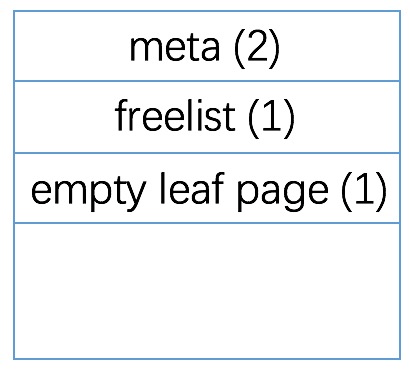
然后就是各种初始化了,初始化 pagePool,mmap the data file as a byte slice,初始化 freelist
etcd 的 InitialMmapSize 设置为 10 1024 1024 * 1024,吓人,那是否 etcd 一启动,就会占用这么大的实际内存?并不是的哈,在 mac 上实测 top 命令看到的是 314MB,ps aux 看到的 vsz 556879888,rss 476460,很好奇,按理来说 vsz 的单位应该是 kb 呀,但是这个数字有点儿大的吓人,实际应该是字节,也就是 500 多 MB,那么 rss 又怎么理解呢?rss 的单位又是 kb,实际使用了 470 多 MB?神奇,总之并不是启动之后立马占用 10 G内存
开头写两个一样的 meta page 貌似是为了做保护,看到 mmap 的方法中有这段注释
1 | // Validate the meta pages. We only return an error if both meta pages fail |
说直接一点儿,boltdb 使用 mmap 把一个名为 db 的文件映射到内存中的 []byte 数组,然后直接操作内存,但是不管怎么说是外部存储,最终还是要落盘的,所以呢推测是用了 B+ tree,然后把写入的内容组织成 page,使用指针操作,这块代码有点像 C 其实
freelist allocate 的逻辑是从 freelist 记录的所有 free page 中分配 n 个连续的 page
1 | // allocate returns the starting page id of a contiguous list of pages of a given size. |
freelist 的 write 实现
1 | // read initializes the freelist from a freelist page. |
freelist 的 read 实现,对应 write;如何 write 的,就如何 read
1 | // read initializes the freelist from a freelist page. |
freelist 的 reindex 实现,其实就是构造 cache,很直接的实现
1 | // reindex rebuilds the free cache based on available and pending free lists. |
boltdb 在 beginRWTx 中释放空间
1 | func (db *DB) beginRWTx() (*Tx, error) { |
查看 db.freelist.release 的实现
1 | // release moves all page ids for a transaction id (or older) to the freelist. |
leafPageElement 结构
1 | type leafPageElement struct { |
如图所示
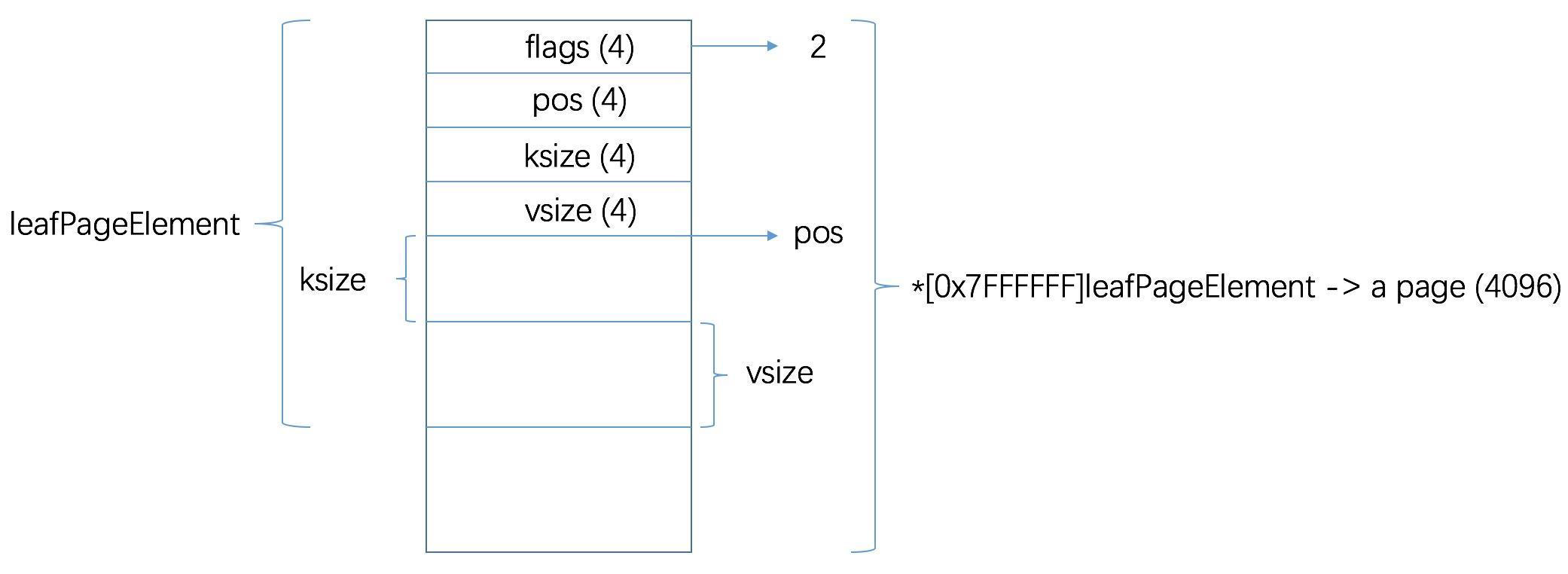
即叶子节点中存储了 key 和 value
查看 mvcc/kvstore.go 的 func (s *store) put(key, value []byte, leaseID lease.LeaseID) 方法
查看如下
1 | func (s *store) put(key, value []byte, leaseID lease.LeaseID) { |
查看 kvindex 的实现,实际上为 newTreeIndex(),即 mvcc/index.go,摘抄一句 package 注释
Package btree implements in-memory B-Trees of arbitrary degree.
okay, index 底层是 B tree
查看 kvindex.put 方法
1 | func (ti *treeIndex) Put(key []byte, rev revision) { |
kvindex 是个完全在内存中的索引,如果 etcd 重启了之后,需要恢复 kvindex 么?答案是需要的
etcdserver/server.go -> s.kv.Restore(newbe) -> func (s store) Restore(b backend.Backend) error {} -> func (s store) restore() error {}
在最后这个方法中从 db 文件恢复 kvindex
etcd v3.1.9
数据是如此重要,有必要看下 etcdctl restore 的实现
etcdctl 的实现均在 etcdctl 目录下,ctlv2 是 v2 的实现,ctlv3 是 v3 的实现,统一入口 main.go,通过环境变量 ETCDCTL_API 指定使用哪个版本的 etcdctl
查看 etcdctl/ctlv3/command/snapshot_command.go 中的 snapshotRestoreCommandFunc 方法
具体查看 makeDB 方法
1 | // makeDB copies the database snapshot to the snapshot directory |
具体查看 makeWALAndSnap 方法,无图言 x,makeWALAndSnap 生成的 .wal 和 .snap 文件内容如下
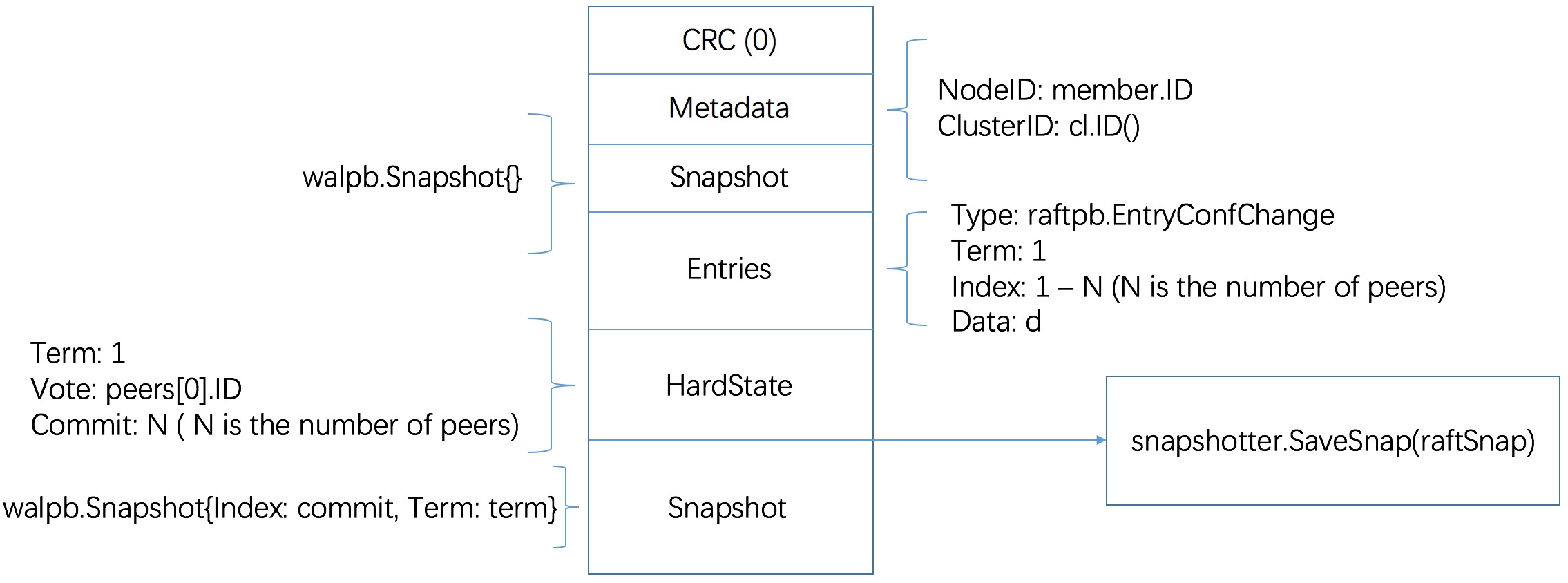
代码注释如下
1 | // makeWAL creates a WAL for the initial cluster |
etcd 完成一次写入需要经过哪些过程?
implementation of put grpc request
key.go
1 | func (s *kvServer) Put(ctx context.Context, r *pb.PutRequest) (*pb.PutResponse, error) |
v3_server.go
1 | func (s *EtcdServer) Put(ctx context.Context, r *pb.PutRequest) (*pb.PutResponse, error) |
v3_server.go
1 | func (s *EtcdServer) processInternalRaftRequest(ctx context.Context, r pb.InternalRaftRequest) (*applyResult, error) |
v3_server.go
1 | func (s *EtcdServer) processInternalRaftRequestOnce(ctx context.Context, r pb.InternalRaftRequest) (*applyResult, error) |
注册一个等待 id;完成之后调用 s.w.Trigger 触发完成 or GC
ch := s.w.Register(id)
raft propose (提议写入数据)
1 | // propose PutRequest |
node.go
1 | func (n *node) Propose(ctx context.Context, data []byte) error |
n.step 往 propc 通道传入数据
node run main roop
1 | func (n *node) run(r *raft) { |
raft/raft.go
1 | func (r *raft) Step(m pb.Message) error { |
r.step(r, m)
leader 和 follower 行为不同
对于 follower 来说
1 | func stepFollower(r *raft, m pb.Message) { |
r.send(m) 只是把 message append 到 raft/raft.go 的 msgs []pb.Message 数组中,谁去消费这个 message ?
node.go
1 | func newReady(r *raft, prevSoftSt *SoftState, prevHardSt pb.HardState) Ready { |
Ready 又是由谁消费的?
node.go main roop
func (n node) run(r raft)
1 | func (n *node) run(r *raft) { |
readyc 又由谁消费呢?
实际上 readyc 是 n.readyc,所以找下 n.readyc 由谁消费即可
1 | type node struct { |
所以我们继续追寻哪里取了 Ready() 通道
终于在
etcdserver/raft.go 中发现了
1 | func (r *raftNode) start(rh *raftReadyHandler) { |
该部分会将 apply 的 message 放入 applc 通道中,最终由
server.go
1 | func (s *EtcdServer) run() { |
做持久化,并且 trigger 写入结束
etcd v3.1.9
.wal 文件,即 write ahead log,wal 的实现集中在 wal 目录下
其中 wal/walpb 目录下定义了 wal 中记录的两种消息类型: Record 和 Snapshot
1 | message Record { |
用 pb 比较省事儿,不用自己实现对象序列化反序列化的逻辑
wal 有两个方法会创建 wal 文件,一个是 Create 方法,另一个是 cut 方法
Create 方法会创建初始 wal 文件,名称为 0000000000000000-0000000000000000.wal
1 | p := filepath.Join(tmpdirpath, walName(0, 0)) |
查看 Create 创建初始 wal 文件的过程
1 | // keep temporary wal directory so WAL initialization appears atomic |
w.renameWal(tmpdirpath) 值得抽出来说下
1 | // 删除原 wal path |
初始写入 wal 内容示意如下
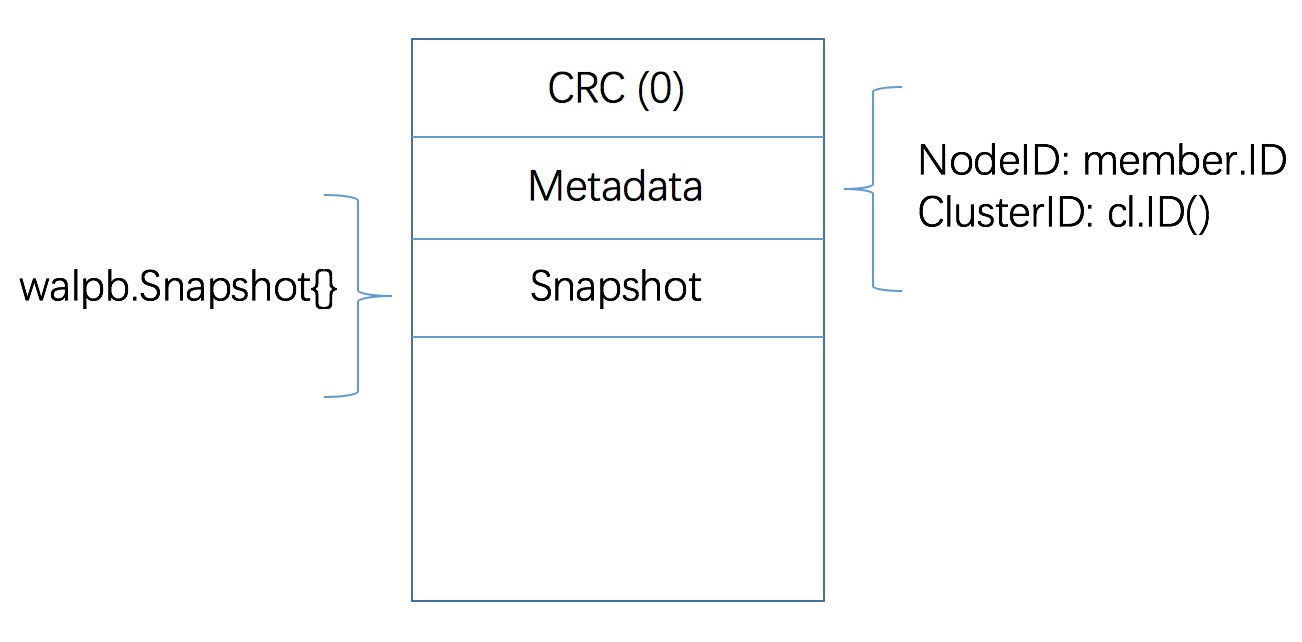
在 unix OS 上,首先会使用系统调用 Fallocate 预分配文件空间
如果 Fallocate 失败,则 fallback 到 preallocExtendTrunc 再次尝试分配
查看 preallocExtendTrunc 的逻辑
1 | // 移动到文件的当前读写位置,返回 offset |
在 darwin OS 上,首先会调用 preallocFixed,该函数中使用了系统调用 SYS_FCNTL 预先分配文件空间
如果 preallocFixed 失败,则调用 preallocExtendTrunc 再次尝试分配
wal/encoder.go 实现了写入逻辑
wal/decoder.go 实现了读取逻辑
wal/file_pipeline.go 用来预创建文件,为后续生成新的 wal 文件使用
fp.Open() 在 cut 方法中被调用,cut 中的调用如下
1 | // create a temp wal file with name sequence + 1, or truncate the existing one |
而 fp.Open() 从 fp.filec 中获取 locks file 返回
在初始化 file pipeline 方法 newFilePipeline 中启动 fp.run() 协程,查看 fp.run() 实现
1 | func (fp *filePipeline) run() { |
查看 fp.alloc() 方法
1 | func (fp *filePipeline) alloc() (f *fileutil.LockedFile, err error) { |
可见预生成了 [0-1].tmp 文件,并对该文件加了锁,待调用 fp.Open() 方法获取使用
wal 文件大小上限为 64MB
因此当写入消息之后, wal 文件大小 > 64MB 时,会调用 cut 方法
截断之前的 wal 文件,并生成新的 wal 文件用于写入
cut 的整体思路
详细阅读 cut 方法(保留了原注释)
1 | // cut closes current file written and creates a new one ready to append. |
所以 cut 方法初始写入 wal 的内容示意如下
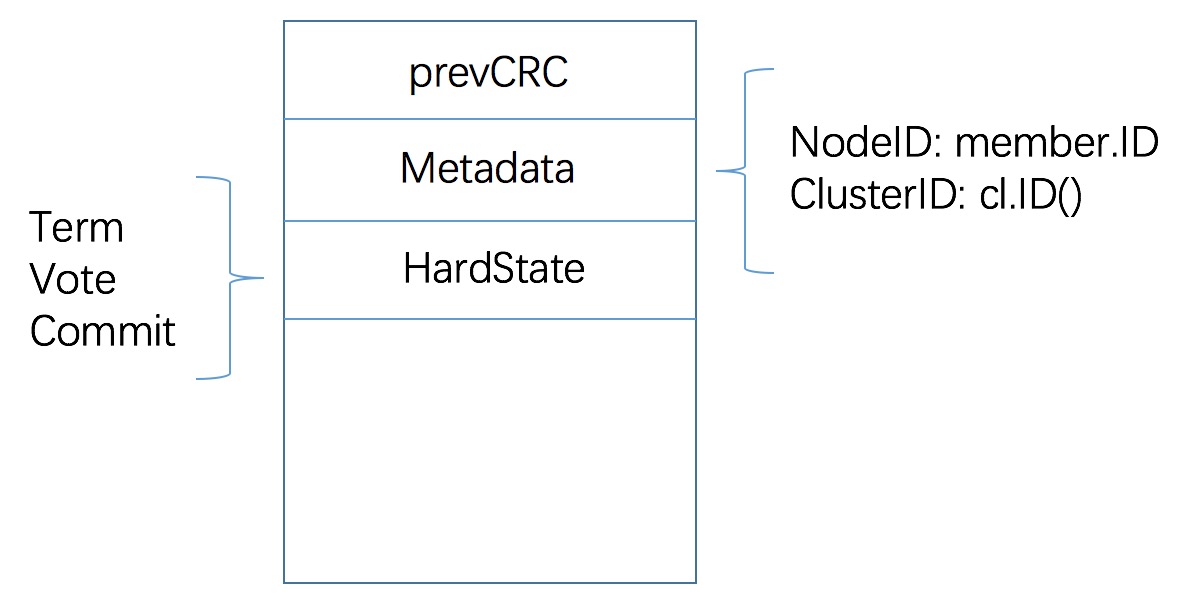
在 wal 中有如下几个地方使用了 sync 方法
sync 直接来说是使用了系统调用 fsync,确保数据写入磁盘持久化
1 | func (w *WAL) sync() error { |
重点看下 func (w *WAL) Save(st raftpb.HardState, ents []raftpb.Entry) error 方法,毕竟它调用频率较高
1 | func (w *WAL) Save(st raftpb.HardState, ents []raftpb.Entry) error { |
从上: vote / term 变化,或有 entries 要写入时,调用 w.sync
etcd v3.1.9
clientURL/health
1 | curl http://localhost:2379/health |
peerURL/members
1 | curl http://localhost:2380/members |
/raft
接收 raftpb.Message 消息,传递给 raft.Process 处理
检查 request id 是否已经被 remove
从 local 中获取 peer,如果不存在,则加入 remote 中 trace,并提示
1 | failed to find member [mid] in cluster [cid] |
检查 x-raft-to id 是否与本成员一致
(1) /raft/stream/msgapp
处理 streamTypeMsgAppV2 消息类型;建立 stream 链接,保持 w http.ResponseWriter
(2) /raft/stream/message
处理 streamTypeMessage 消息类型;建立 stream 链接,保持 w http.ResponseWriter
/raft/snapshot
/raft/probing
etcd v3.1.9
基于 protocol buffer,使用 gRPC 框架实现
示例代码:https://github.com/grpc/grpc-go/tree/master/examples
简单易用
pb 定义位于 etcdserver/etcdserverpb/rpc.proto 中,service 中定义了一系列 RPC 方法,RPC 中的 request 和 response 则在 service 之后被定义
使用 scripts/genproto.sh 可根据 pb 文件生成 go 文件
也可以根据官方文档使用 protoc 工具,从 pb 文件生成 go 文件
由 .proto 文件生成的 go 文件有两,如
1 | rpc.pb.go |
其中 rpc.pb.gw.go 是个反向代理,是将 http 请求再封成 grpc 发送至后端;按我理解就是方便使用 curl 命令调试
详情参考 ref: https://grpc.io/blog/coreos
下图源自上述网址,清晰明了;无图言 x
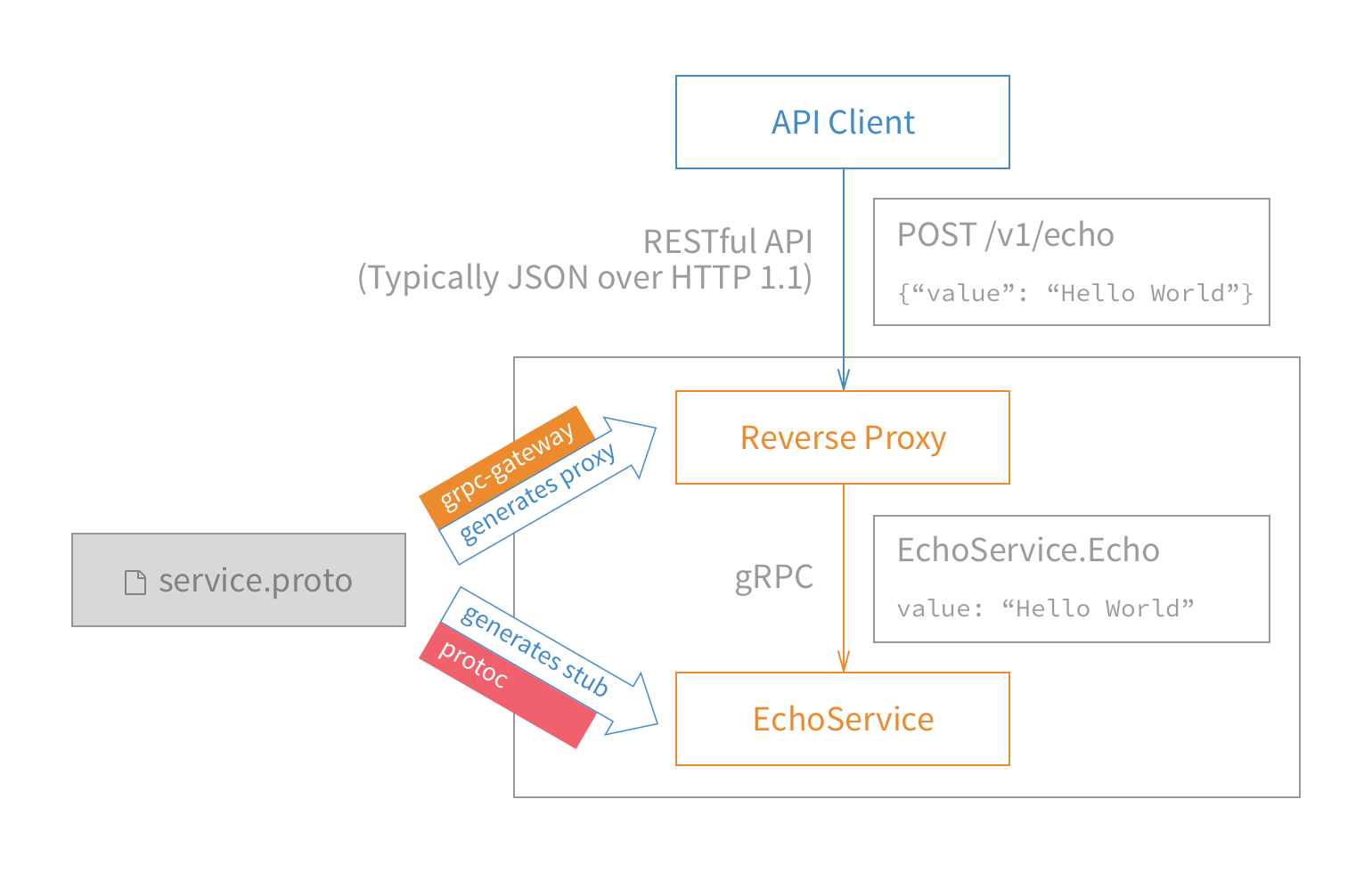
gRPC 的入口位于 etcdserver/api/v3rpc/grpc.go
该文件中 new 了 grpc server,注册了 pb 中定义的一系列 service,并返回 grpc server
v3 中保有 peer http,client http 及 client grpc
因此 v3 只是对 client 的 api 变为了 gRPC,peer 之间的通信仍然沿用 v2 的套路